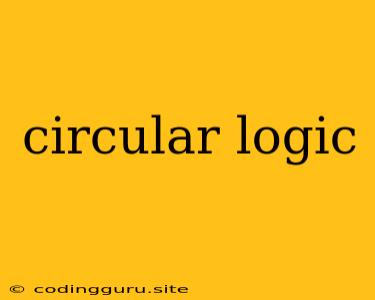What is Circular Logic and Why is it a Problem?
Circular logic, also known as circular reasoning, is a logical fallacy that occurs when an argument's conclusion is used as one of its premises. This creates a closed loop where the argument essentially argues for itself without providing any independent evidence. It's like saying "the sky is blue because it's blue" – the statement doesn't offer any explanation or evidence.
Think of it this way: Imagine you're trying to convince someone that the Earth is flat. You say, "The Earth is flat because the Bible says so. And the Bible is true because it's the word of God. And God wouldn't lie, because God is perfect." This argument is circular because it relies on the Bible being true to prove that the Earth is flat, while also relying on the Earth being flat to prove the Bible is true.
How to Spot Circular Logic
Identifying circular logic can be tricky, especially in complex arguments. Here are some telltale signs:
- The argument repeats the same idea in different words: It essentially says the same thing over and over without providing new information.
- The conclusion is simply a restatement of the premise: The argument goes in a circle, leading back to the starting point without offering any new insights.
- The argument relies on assumptions that haven't been proven: It takes something for granted without providing evidence, making it unreliable.
Why is Circular Logic a Problem?
Circular logic is a problem because it fails to provide any real support for its claims. It's like building a house on a foundation of sand – it might look sturdy, but it will inevitably crumble under scrutiny.
Here's why circular reasoning is unreliable:
- It doesn't offer any new information: It merely restates the same idea in different words, providing no evidence or explanation.
- It doesn't prove anything: It only reinforces the initial premise, making it difficult to distinguish between truth and falsehood.
- It's easy to manipulate: Circular arguments can be used to justify almost anything, regardless of whether it's true or not.
Examples of Circular Logic
- "The Bible is true because it's the word of God, and God wouldn't lie." This argument assumes God's truthfulness to prove the Bible's truthfulness, while also assuming the Bible's truthfulness to prove God's truthfulness.
- "Everyone loves the new movie because it's the most popular movie right now." This argument relies on the movie's popularity to prove that people love it, while also relying on people loving it to prove its popularity.
- "You should believe me because I'm always right." This argument assumes that the speaker is always right to prove that you should believe them, while also assuming that you should believe them to prove that they are always right.
How to Avoid Circular Logic
Avoiding circular logic in your arguments is crucial for maintaining logical consistency and credibility. Here are some tips:
- Be mindful of your premises: Make sure your premises are independent of your conclusion. Avoid using the conclusion as a premise.
- Look for supporting evidence: Back up your claims with evidence, facts, and reasoning. Don't just restate your conclusion in different words.
- Be open to challenging your assumptions: Examine your premises critically and be willing to reconsider them if they don't hold up under scrutiny.
- Consider alternative explanations: Don't assume that your explanation is the only possible one. Explore other perspectives and consider alternative interpretations.
Conclusion
Circular logic is a logical fallacy that undermines the credibility of arguments. By recognizing the telltale signs of circular reasoning and actively avoiding it in your own arguments, you can enhance the clarity and reliability of your communication. Remember, a strong argument is built on sound reasoning and evidence, not circular justifications. By understanding and avoiding circular logic, you can improve the quality of your own arguments and become a more critical thinker.
